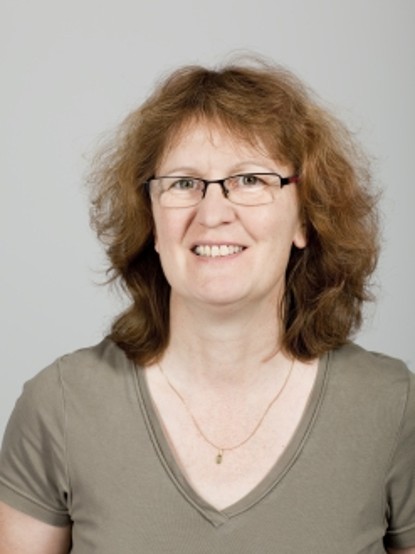Challenges of modelling the moving contact line problem and recent progress: bridging scales from the nano- to the macroscale
Talk by Serafim Kalliadasis (Imperial College London)
12.07.2019
The moving contact line problem occurs when modelling one fluid replacing another as it moves along a solid surface, a situation widespread throughout industry and nature. On July 12th, 2019, Serafim Kalliadasis (Imperial College London) will hold a talk on the challenges of modelling the moving contact line and will present a new multiscale model. Mathis Fricke (CRC 1194, project B01) will hold a CRC talk entitled „Numerical Simulation of the Breakup Dynamics of Capillary Bridges on Structured Surfaces“.
Classically, the no-slip boundary condition at the solid substrate, a zero-thickness interface between the fluids, and motion at the three-phase contact line are incompatible – leading to the well-known shear-stress singularity. At the heart of the problem is its multiscale nature: a nanoscale region close to the solid boundary where the continuum hypothesis breaks down, must be resolved before phenomenological macroscale parameters such as contact line friction and slip, often adopted to alleviate the singularity [1], can be obtained.
In his talk, professor Kalliadasis will review progress made by his group considering the moving contact line problem and related physics from the nano- to macroscopic lengthscales. Specifically, to capture nanoscale properties very close to the contact line and to establish a link to the macroscale behaviour, Kalliadasis and coworkers employ elements from the statistical mechanics of classical fluids, namely density-functional theory (DFT) [2,3]. The group formulates a new and general dynamic DFT (DDFT) [4] that carefully and systematically accounts for the fundamental elements of any classical fluid and soft matter system, a crucial step towards the accurate and predictive modelling of physically relevant systems. In a certain limit, this DDFT reduces to a non-local Navier-Stokes-like equation [5]: an inherently multiscale model, bridging the micro- to the macroscale, and retaining the relevant fundamental microscopic information (fluid temperature, fluid-fluid and wall-fluid interactions) at the macroscopic level.
Work analysing the contact line in both equilibrium and dynamics will be presented [6,7]. The new model allows to benchmark existing phenomenological models and reproduce some of their key ingredients. But its multiscale nature also allows to unravel the underlying physics of moving contact lines, not possible with any of the previous approaches, and indeed show that the physics is much more intricate than the previous models suggest. For instance, a key property captured by the theory is the fluid layering on the wall-fluid interface, amplified as the contact angle decreases. But also the existence of compressive interfacial regions on the vapor side of the vapor-liquid interface and a large-shear region close to the wall in which effective slip can be generated. Professor Kalliadasis will demonstrate that the stratified fluid structure in the vicinity of the wall has a large effect on the compression and shearing properties of the fluid. He also scrutinizes the effect of stratification on contact line friction and the dependence of the latter on the imposed temperature of the fluid and motion orientation [8].
Serafim Kalliadasis heads the research group Complex Multiscale Systems and is professor in Engineering Science and Applied Mathematics at the Faculty of Engineering and the Department of Chemical Engineering at Imperial College London. His systems of interest cross the boundaries between engineering science, physics, chemistry and biology. Particular emphasis is given to mathematical-theoretical physics, fluid mechanics and pattern formation driven by coupled hydrodynamic and reaction-diffusion instabilities.
Selected references:
[1] D.N. Sibley, A. Nold and S. Kalliadasis 2015 „The asymptotics of the moving contact line: cracking an old nut,“ J. Fluid Mech. 764, 445-462.
[2] P. Yatsyshin, N. Savva and S. Kalliadasis 2015 „Wetting of prototypical one- and two-dimensional systems: Thermodynamics and density functional theory,“ J. Chem. Phys. 142, Art. No. 034708.
[3] P. Yatsyshin, A.O. Parry and S. Kalliadasis 2016 „Complete prewetting,“ J. Phys.: Condens. Matter 28, Art. No. 275001.
[4] B.D. Goddard, A. Nold, N. Savva, G.A. Pavliotis and S. Kalliadasis 2012 „General dynamical density functional theory for classical fluids,“ Phys. Rev. Lett. 109, Art. No. 120603.
[5] B.D. Goddard, A. Nold, N. Savva, P. Yatsyshin and S. Kalliadasis 2013 „Unification of dynamic density functional theory for colloidal fluids to include inertia and hydrodynamic interactions: derivation and numerical experiments,“ J. Phys.: Condens. Matter 25, Art. No. 035101.
[6] A. Nold, D.N. Sibley, B.D. Goddard and S. Kalliadasis 2014 „Fluid structure in the immediate vicinity of an equilibrium three-phase contact line and assessment of disjoining pressure models using density functional theory,“ Phys. Fluids 26, Art. No. 072001.
[7] A. Nold, D.N. Sibley, B.D. Goddard and S. Kalliadasis 2015 „Nanoscale fluid structure of liquid-solid-vapor contact lines for a wide range of contact angles,“ Math. Model. Nat. Phenom. 10, 111-125.
[8] A. Nold, PhD Thesis, Imperial College London (2016).
Date & time:
July 12, 2019, 11:00 hrs
Venue:
Alarich-Weiss-Str. 10, 64287 Darmstadt
Building L2|06, Room 100

